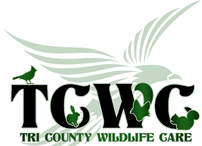Just Say NO to Trapping
Sometimes wildlife can be a problem around our homes and gardens and seem like a nuisance. You try to find ways to handle the problems, but they are not always successful. Our page on Nuisance Wildlife will provide you with information on how to live peaceably with the wildlife species around you and includes recommendations for safe, alternative solutions.
Though it may seem like a perfect solution, live trapping wildlife and relocating to another area does not solve your problem and it creates many more.
Trapping separates the parents from their babies
One problem with trapping is separating parents from their babies. Now you are left with offspring that do not know how to take care of themselves and will do whatever they can to survive. Without their parents to tell them how to survive, they may turn to your garbage and other human sources for food which compounds the problem you wanted to correct.
They have lost their escape routes
Next, releasing that animal in some new forested environment near a babbling brook seems wonderful to us, but it is like taking them to another country. They are unlikely to survive in this strange land. Without their local internal GPS, they do not know where to find food, where to find a den to sleep, or where to escape when a predator comes their way. And, if your property was a desirable home for one wild critter, trapping one animal just leaves room for another one to move in. In one study where squirrels were relocated, 97% died in less than three months. Other species show similar poor survival rates when relocated.
What to do?
Many animals keep multiple den sites as backup in case they need to move. We just need to give them a chance to relocate their family. We can encourage them by using light and sound to harass and make them move of their own accord. And keep your property free of dog or cat food so you are not feeding wildlife as well as your pets.
Most of these animals also do us a service by eating rodents and insects. Removing the wildlife leaves the rats, mice and insects behind. Visit our page on nuisance wildlife for many alternatives to live trapping.
And enjoy the wildlife around you. Watch, listen, photograph, and realize they are a lot like us. They are just trying to raise a family, keep everyone well fed, and stay warm and safe.
Though it may seem like a perfect solution, live trapping wildlife and relocating to another area does not solve your problem and it creates many more.
Trapping separates the parents from their babies
One problem with trapping is separating parents from their babies. Now you are left with offspring that do not know how to take care of themselves and will do whatever they can to survive. Without their parents to tell them how to survive, they may turn to your garbage and other human sources for food which compounds the problem you wanted to correct.
They have lost their escape routes
Next, releasing that animal in some new forested environment near a babbling brook seems wonderful to us, but it is like taking them to another country. They are unlikely to survive in this strange land. Without their local internal GPS, they do not know where to find food, where to find a den to sleep, or where to escape when a predator comes their way. And, if your property was a desirable home for one wild critter, trapping one animal just leaves room for another one to move in. In one study where squirrels were relocated, 97% died in less than three months. Other species show similar poor survival rates when relocated.
What to do?
Many animals keep multiple den sites as backup in case they need to move. We just need to give them a chance to relocate their family. We can encourage them by using light and sound to harass and make them move of their own accord. And keep your property free of dog or cat food so you are not feeding wildlife as well as your pets.
Most of these animals also do us a service by eating rodents and insects. Removing the wildlife leaves the rats, mice and insects behind. Visit our page on nuisance wildlife for many alternatives to live trapping.
And enjoy the wildlife around you. Watch, listen, photograph, and realize they are a lot like us. They are just trying to raise a family, keep everyone well fed, and stay warm and safe.


